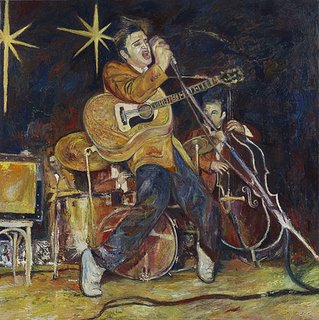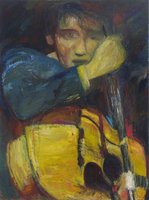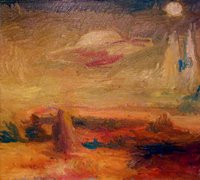Friday, October 20, 2006
Kings and Queens, Anima and Anime

We are buzzing about Keith Mayerson's new show, Kings and Queens, opening tonight at Derek Eller. We are familiar with Keith's work, have seen him lecture, and even had a group crit with him. He teaches at NYU and SVA. When we write a book, he'll have a chapter. (We're pretty sure our over-eagerness gets on his nerves, despite his hippie/saint kindness, but we still like him.) Since around the year 2000, Keith's paintings have been idols - stars and scenes significant in pop culture - rendered in a soupy, gunky manner and muddy, pukey palette. His previous work has included abstract tunnels, "Pinocchio the Big Fag," and "Horror Hospital: Unplugged," with Dennis Cooper.


Keith funnels together semiotics, Jung, Warhol, Kilimnik, and Surrealism and Abexism:
With semiotics, he understands pop icons as symbols of the surrounding culture's appetite;
With Jung, these icons are archetypes and probably our collective Anima and Animus. Arch villains like Darth Vader are our shadow. And the many heroes - Robin Hood, Harry Potter, Princess Mononoke - employ Jung's concept of the Hero Myth. (We've also heard Keith praise Joseph Campbell). Keith's twist on this is to select many gay icons and divas - Judy Garland, Montgomery Clift, Rimbaud - cleverly confusing the gender-specificity of Jung's concept;
Jung also informs his painting style, driven by improvisation and intuition. Though he bases his paintings on photos, they brim with spontaneity and individuation, as if made from memory. So the pop image seems to have bubbled up from the collective unconscious, just as spooky creatures and orifices would bubble into an early surrealist, "Automatic" drawing by Pollock or Gorky;
Like Warhol, Keith uses the pop icon. But Keith does it to examine the needs of the culture. A culture celebrating Keanu Reeves as its champion is different than one celebrating John Wayne (see Hero Myth, above);

Kilimnik, Keith's kin, also mixes handwritten text and image, and renders pop figures in "bad" manner, as opposed to neat rendering and harmonious palettes, bypassing their glamour as a means to commenting on it. This takes us back to Pop Art, before it was shiny, glossy, and hard-edged; and instead messy, woody, and scrappy;
We mentioned Surrealism and AbEx painting because those artists tried to channel the collective unconscious into their work, or at least to abandon rationality and pursue irrational, intuitive approaches to their work.
Thus, Keith's iconography is actually our culture's iconography; his heroes are ours, despite the culture wars. We're waiting for a Village People painting.
In his past, Keith rocketed out of UC Irvine's grad program with the aforementioned "Pinocchio," a narrative about Pinocchio in a sexual crisis propelling him through a range of characters and places, almost like Dante's Inferno. His "Pet Paintings" were Soutine lite, expressively painted pups with hilarious twists, like a well-hung chihuahua. Other work brought him into prestigious places such as Jay Gorney, Luhring Augustine, and Mary Boone. "Illuminations" might be based on his return to Southern California, and how interesting to see those landscapes return in his "Forbidden Planet," 2002...


Anyway, why are we saying so much? Surely, you can see it yourself.
Comments:
<< Home
Saw the show Thursday. I was very impressed. The work is much stronger in person, some good painting.
Post a Comment
<< Home


